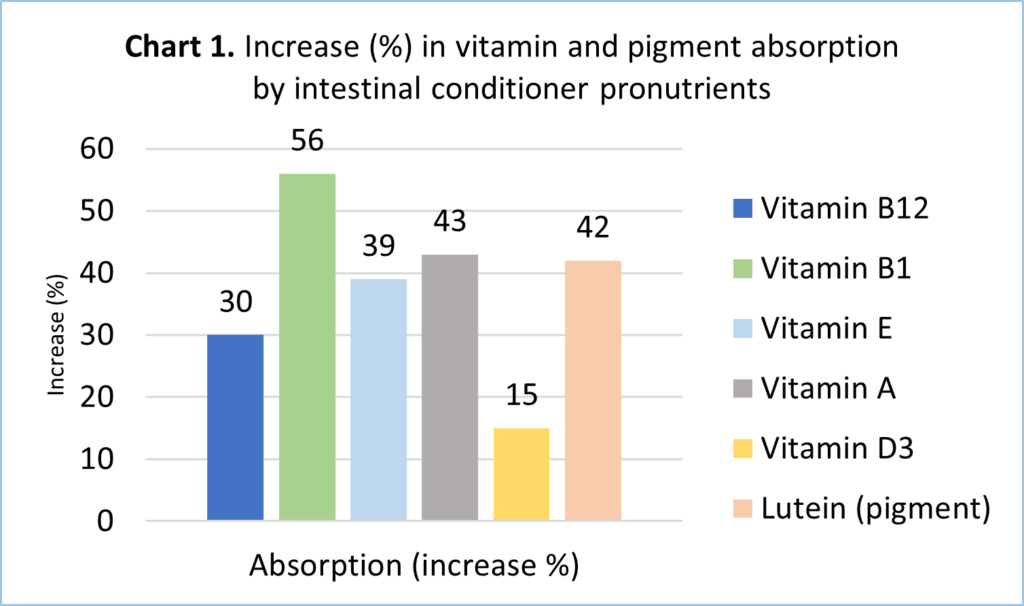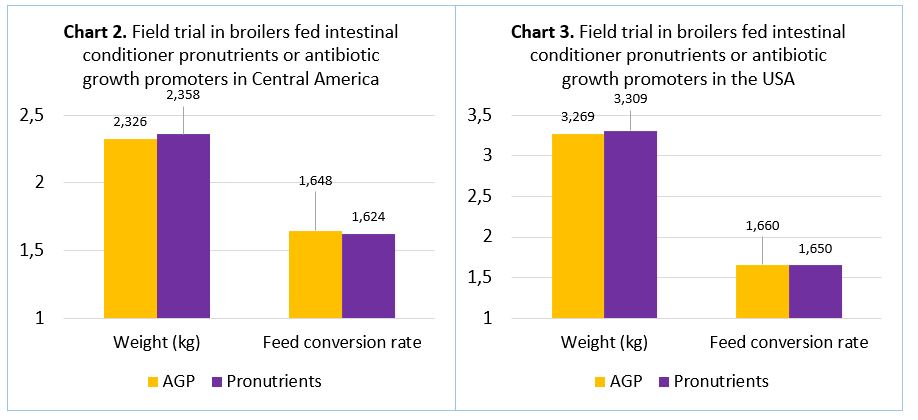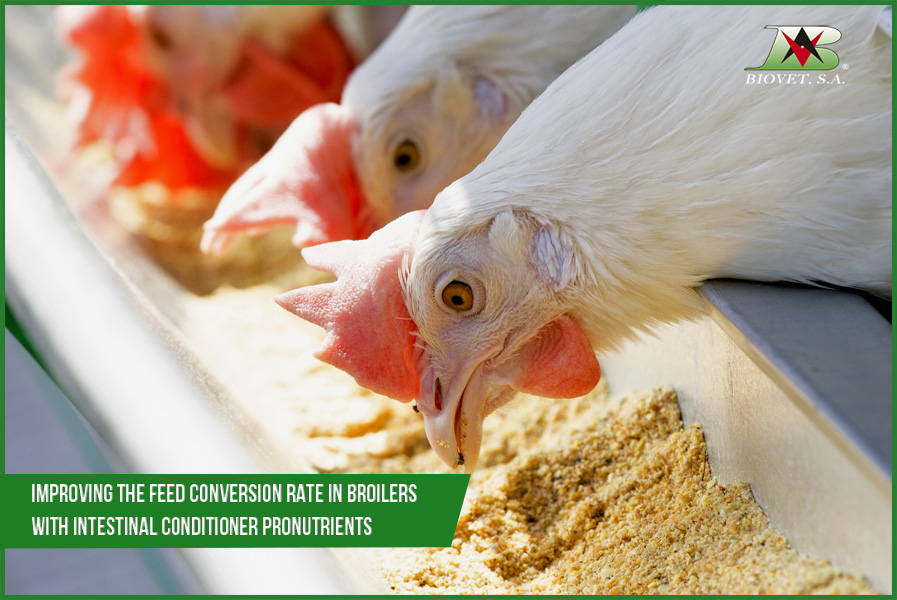Improving the feed conversion rate in broilers with intestinal conditioner pronutrients
Feed conversion rate and its impact on economic performance
The feed conversion rate indicates the capacity of an animal to convert feed into body mass. It is calculated as the amount of feed needed to increase one weight unit.
Feed is one of the main costs in broiler production, therefore, improving the feed conversion rate is one of main factors to optimize economic performance, as it will reduce the amount of feed that is necessary to obtain the same weight, which, in turn, reduces feed costs.

High feed conversion rates mean that diet utilization is not efficiency, which increases feed costs. This is why it is very important to control any factor that increases feed conversion.
Use of pronutrients to improve feed conversion rate in broiler production
Highly concentrated diets are used in industrial production to achieve the high productive standards in commercial breeds, which are required to supply enough nutrients [1]. Industrial feeds do not consider pronutrient needs, which leads to an insufficient function of the organs and, therefore, the worsening of productive performance and increase of the prevalence of some diseases.
These pronutrients, molecules from a plant origin, are essential for the proper physiology of the organs. They can be classified into different groups depending on their target organ, and the ones with a greater impact on feed conversion are the intestinal conditioners [2].
When a diet does not supply pronutrients, the gut mucosa functions at a suboptimal level and loses integrity and efficiency, which worsens the feed conversion.
Effect of intestinal conditioner pronutrients on feed efficiency
Intestinal conditioner pronutrients stimulate specific genes in enterocytes to improve their physiology. This is translated into an optimization of nutrient absorption surface (image 1) [2], [3] and a better status of the gut villi, improving the feed efficiency.

Image 1. Micro and macroscopy of the gut mucosa with and without pronutrients. The presence of undigested feed, microorganisms and lack of tissue integrity can be observed in birds that did not receive pronutrients. Birds with pronutrients show a much more organized, consistent mucosa.
Pronutrients’ mechanism of action consists in inducing the reading of specific genes in the DNA, such as CD1E and RIMBP2, related to the regeneration, nutrient absorption and other physiological functions of the enterocytes [4], [5].
Biovet’s R&D department conducted cellular and molecular studies following the scientific method to define what genes are upregulated with intestinal conditioner pronutrients and to prove their efficacy to enhance intercellular adhesion (tight junctions) and vitamin, amino acid, and pigment absorption (chart 1) [6].

Thanks to the mechanism of action based on improving cell physiology, pronutrients make the mucosa more resistant to infections (cells are newer, in a better status, and much more resistant to pathogens) and reduce the presence of undigested feed in the gut, which can act as a substratum for pathogen multiplication. These reasons make pronutrients a suitable solution to replace antibiotic growth promoters [7], [8] and avoid the development of resistances, since they do not directly act on microorganisms.
Field trials with intestinal conditioner pronutrients
Multiple trials were conducted in experimental and commercial farms to prove that intestinal conditioner pronutrients in the feed or in the drinking water, at small dose rates, improve diet utilization and, in consequence, reduce the feed conversion rate.

Image 2. World map. Red circles indicate some of the countries where intestinal conditioner pronutrients were tested.
In a trial with broilers conducted in Central America (chart 2), pronutrients in the feed at a dose rate of 0.5 kg/t improved final weight by 32 g/bird and feed conversion by 1.64%. Results show that a farm with one million broilers would produce 56.6 more tons of meat and save 32 tons of feed thanks to using intestinal conditioners.
Another trial conducted in the United States (chart 3) compared the parameters obtained with bacitracin methylene disalicylate, an antibiotic growth promoter, and intestinal conditioner pronutrients. The latter obtained greater weight (+40 g/bird) and improved feed conversion by 0.6%, which means that every one million broilers, a farm would save 33 tons of feed and produce 40 more tons of meat.

Improving feed conversión to reduce production costs in broilers
Improving feed conversion is key to reduce costs in a farm and, therefore, has a positive impact on economic performance. This improvement can be achieved by adding intestinal conditioner pronutrients in the diets and/or the drinking water, since they are essential molecules necessary for the gut mucosa to work properly.
Field trials proved that these pronutrients physiologically activate cells in the digestive mucosa to optimize their functions and improve the status of the epithelium, this way, animals can reach greater weights with lower feed intakes. The efficacy of pronutrients was corroborated in multiple field trials where broilers obtained higher weights (between 32 and 40 more grams) and lower feed conversion rates (0.60 to 1.64% reduction).
This technology, developed and patented by Biovet S.A., can replace antibiotic growth promoters in a natural way. Thanks to their mechanism of action, they do not cause resistances, do not leave residues in animals, and do not require a withdrawal period.
Intestinal conditioner pronutrients were developed and patented by Biovet S.A. They are marketed under the name Alquernat Nebsui. And available in powder and liquid to be included in the feed or the drinking water. They are available for organic production.
Bibliography
[1] D. A. Emmerson, “Commercial Approaches to Genetic Selection for Growth and Feed Conversion in Domestic Poultry,” Poult. Sci., vol. 76, no. 8, pp. 1121–1125, 1997.
[2] J. Borrell, “Uso de pronutrientes de origen natural en veterinaria,” RACVE (Real Acad. Ciencias Vet. España), 2005.
[3] M. K. Sharma, T. Dinh, and P. A. Adhikari, “Production performance, egg quality, and small intestine histomorphology of the laying hens supplemented with phytogenic feed additive,” J. Appl. Poult. Res., vol. 29, no. 2, pp. 362–371, 2020.
[4] J. Borrell, C. Domenech, N. Martin, and A. Tesouro, “Pronutrients use in poultry nutrition (S11-0224),” in XXV World’s Poultry Congress, 2016, p. 97.
[5] N.D., “Identificación de genes y proteínas tejido-específicas inducidos por un acondicionador intestinal,” Veterinaria Digital. Technonews2, 2019. [Online]. Available at: https://www.veterinariadigital.com/post_blog/acondicionador-intestina-identificacion-genes-y-proteinas-tejido-especificas-inducidos/.
[6] N.D., “Los pronutrientes acondicionadores intestinales mejoran la absorción intestinal de aminoácidos,” Veterinaria Digital. Technonews, 2019. [Online]. Available at: https://www.veterinariadigital.com/post_blog/pronutrientes-acondicionadores-intestinales-mejor-absorcion-intestinal-aminoacidos-porcino/.
[7] J. Pie, A. Tesouro, and M. E. Rosemberg, “Use of Alquernat Nebsui (botanical product) as an alternative to antibiotic growth promoter in broilers,” in Poultry Science Association (PSA) 107th Annual meeting abstracts, 2018, p. 105.
[8] J. Pie, “Pronutrientes acondicionadores intestinales frente a promotores de crecimiento en pollos de engorde con un desafío intestinal,” Veterinaria Digital. Technonews, 2020. [Online]. Available at: https://www.veterinariadigital.com/post_blog/pronutrientes-acondicionadores-intestinales-frente-promotores-de-crecimiento-en-pollos-de-engorde-con-un-desafio-intestinal/.






